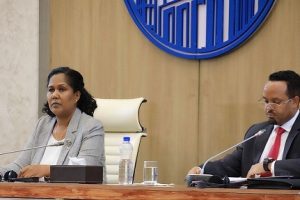
Ethiopia is endowed with huge hydropower potential cascaded from its many rivers. Being a landlocked country with no known fossil fuel resources signifies the importance of water resources, indeed! Despite some recent successful efforts to use these vast water resources for its development, the country has not been able to use this enormous resource fully for bolstering its economic development.
It is strange that the country has an underperforming power sector with supply shortages, reliability issues, and poor access to electricity, while sitting on an enormous potential to produce hydropower. Adequate supply of power with acceptable quality is a precondition for any nation to modernize its economy and to sustain economic growth.
As learnt from the Ethiopian Electric Power (EEP), World Bank finances 500 million USD to support energy sector. It has also finalizes to launch 14 new projects. The World Bank Group has financed more than 500 million USD budget to support Ethiopia’s energy sector.
EEP Director General Ashebir Balcha told The Ethiopian Herald that there are different organizations and countries that have been financing to support Ethiopia’s energy sector. The World Bank and the African Development Bank are partners in supporting country’s energy sector.
“The World Bank has recently funded over 500 million USD. Accessing this budget, EEP drafted to launch some 14 new power generation and transmission as well as distribution projects across the country. The fund would contribute highly in overcoming power accessibility problems and others. Hence, there are public queries to build substations and fulfill power accessibility and others. The realization of these 14 projects would address the problem,” he added.
According to him, the country has been working to rehabilitate hydropower projects to boost power generation. As a result, electro mechanical components should get rehabilitation after 20 years service provision. Currently, there are projects that need rehabilitation. For instance, efforts are underway to rehabilitate Tekeze hydropower project to boost power generation.
Currently, all of energy sources have been yielding 5250MW. The Abbay Dam project construction completion would double the current energy capacity. Hence, the construction of Koisha hydroelectric power project completed 65%. Currently, shortage finance especially foreign currency exchange has been challenging the project.
However, the government has been eyeing various alternatives to address the problem. And the EEP has been allocating its foreign currency revenue for it. Furthermore, it will commence power generation after three to four years, he underscored.
Ethiopia has been exporting electricity to neighboring countries after fulfilling its local power demand. Currently, it exports only 10% of it to neighboring countries and uses 85% of it for its local consumption, he expressed.
The greatest benefit out of hydropower program is the abundant low-cost energy the projects contribute to electric power grids. Because hydroelectric power plants burn no fuel, operating costs are low and are immune to rising fossil fuel prices. In addition, most of these projects were built years ago, when construction costs were low. As a result, these plants are playing a significant role in keeping electricity costs affordable for consumers, creating a positive impact on the economy.
As to him, in most parts of the country, hydropower plants can only meet a portion of an area’s power needs. Ethiopia strives to use this limited amount of energy in a way that will keep the overall cost of electricity to consumers as low as possible. This is often done by generating as much energy as possible during peak demand hours of the day.
“Hydropower development is a controversial topic as it potentially has significant environmental and social impacts. However, hydropower has received favorable consideration recently due to its potential to mitigate climate change. It uses a computable general equilibrium model to examine the macroeconomic impacts of expanding Ethiopia’s hydropower potential,” he added.
In the long run, hydropower generation expansion increases domestic incomes, lowers real domestic energy prices, significantly alleviates poverty and provides insurance against oil price increases. Moreover, Ethiopia has potential to significantly contribute in providing environmental services to the east African region by delivering clean, renewable energy while mitigating climate change, he opined.
True, properly designed and implemented multipurpose water infrastructure projects also offer other development opportunities such as irrigation, fisheries, and domestic and industrial water supply for developing nations like ours. Hydropower avoids the use of carbon-intensive energy sources such as coal, oil, and gas and also helps integration of other intermittent renewable energy-based power generation sources such as solar and wind power into the main grid, moving economies toward a low-carbon development path.
A call for a renewed role for hydropower nationally, regionally and even continentally needs to be well intensified. True, hydropower dams are too costly to build to deliver positive risk-adjusted returns unless suitable risk management measures are imbedded in project designs. In the long run, hydropower generation expansion, together with the necessary transmission infrastructure development, will significantly increase national income and make, domestic energy cheaper. It also reduces poverty more effectively than electricity subsidies. Moreover, this study shows that Ethiopia has a potential to significantly contribute in providing environmental services.
According to Ashebir, the energy sector plays a very important role in economic development and evidence shows that expanding the electricity sector contributes to economic growth in many countries. The underperforming electricity sector in the country, with inadequate and unreliable supply of poor-quality electricity, was a major development constraint.
It is believed that the recent improvements in electricity supply to the industrial and service sectors have contributed to better economic growth. This trend in electricity sector growth is expected to continue along with rapid urbanization and a growing number of energy-intensive industries.
Hydropower has the potential to play an important role in Ethiopia, which faces growing demand for clean, reliable, and affordable energy. However, environment and social impacts raised serious concerns about hydropower during the 1990s, and many development agencies reduced their support for hydropower. Growing concerns about climate change has renewed interest in hydropower, he added.
Hydropower can thus deliver remarkable advantages compared to solar energy and wind power, for example in terms of regional value creation and employment, since the share of locally and regionally sourced civil work is typically noticeable higher in total project costs of hydropower.
Additional key aspects for social acceptance are the type of ownership, the degree of local job creation, the level of participation in the planning and decision-making process as well as the amount of financial benefits for communities and cantons from hydropower construction and operation.
A focus on storage hydropower to support the integration of volatile renewable energies would be also advantageous for the country, if site and topographical conditions allow. Undoubtedly, hydropower will remain an important pillar of the Ethiopia’s renewable electricity. Generally, the strategic need for additional hydropower development should be defined in an overall power system planning process.
In fact, the electricity generation from fossil fuels is getting reduced by the increasing share of renewable energy sources. Energy system-related effects refer to additional costs or benefits of renewable energies compared to a “conventional” power or energy system without an increased share of renewable.
Large hydropower tends to be the better option both from an energy-economic as well as environmental and social view. However, there is generally not a linear relationship between size and impact of concrete hydropower projects and possible mitigation measures. Besides, small hydropower plants should be subject to the same environmental regulations as large hydropower plants and need to be included into long-term coordinated planning and assessment at basin-scale. Additionally, renewable strategies and promotion schemes in the country should consider the true environmental and social costs and benefits of small hydropower.
Generally, the expansion of electricity generation from renewable energies is considered to be a major lever for the transition to a more sustainable power system. Furthermore, the expansion of hydropower has caused increasing environmental and social concerns because new hydropower capacities frequently affect river stretches of high ecological value. A robust and climate-resilient generation mix calls for portfolio diversification. Stronger focus on non-hydro renewable technologies and storage hydropower could diversify a country’s generation portfolio and make it less vulnerable to fluctuations of water runoffs.
BY MENGESHA AMARE
THE ETHIOPIAN HERALD WEDNESDAY 10 APRIL 2024




